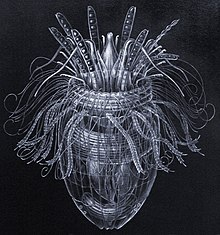| Pliciloricus enigmaticus | |
|---|---|
 | |
| Pliciloricus enigmaticus(Higgins & Kristensen, 1986), [1] illustration by Carolyn Bartlett Gast | |
| Scientific classification | |
| Domain: | Eukaryota |
| Kingdom: | Animalia |
| Phylum: | Loricifera |
| Order: | Nanaloricida |
| Family: | Pliciloricidae |
| Genus: | Pliciloricus |
| Species: | P. enigmaticus |
| Binomial name | |
| Pliciloricus enigmaticus | |
 | |
| Distribution of Pliciloricus enigmaticus | |
Pliciloricus enigmaticus is a marine Loriciferan species of genus Pliciloricus first described by Higgins & Kristensen 1986. [1]